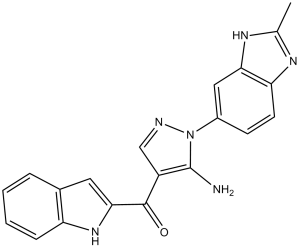CH5183284 (FF-284; Debio-1347)
This product is for research use only, not for human use. We do not sell to patients.

For small sizes, please check our retail website as below: www.invivochem.com
| Size | Price | Stock |
|---|---|---|
| 250mg | $850 | Check With Us |
| 500mg | $1450 | Check With Us |
| 1g | $2175 | Check With Us |
Cat #: V0618 CAS #: 1265229-25-1 Purity ≥ 98%
Description: CH5183284 (also known as FF284; Debio-1347) is a novel, potent, selective and orally bioavailable FGFR inhibitor with potential antitumor activity.
Top Publications Citing Invivochem Products
Publications Citing InvivoChem Products
Product Promise

- Physicochemical and Storage Information
- Protocol
- Related Biological Data
- Stock Solution Preparation
- Quality Control Documentation
| Molecular Weight (MW) | 356.38 |
|---|---|
| Molecular Formula | C20H16N6O |
| CAS No. | 1265229-25-1 |
| Storage | -20℃ for 3 years in powder formr |
| -80℃ for 2 years in solvent | |
| Solubility In Vitro | DMSO: 71 mg/mL (199.2 mM)r |
| Water: <1 mg/mLr | |
| Ethanol: 1 mg/mL (2.8 mM) | |
| SMILES Code | O=C(C1=C(N)N(C2=CC=C3C(NC(C)=N3)=C2)N=C1)C(N4)=CC5=C4C=CC=C5 |
| Synonyms | FF284, CH5183284; Debio1347; CH 5183284; CH-5183284; Debio-1347; Debio 1347; FF-284; FF 284. |
| Protocol | In Vitro | In vitro activity: In cell-based assay, CH5183284 prevents autophosphorylation of FGFR1, FGFR2, and FGFR3 at 100 to 300 nM in the DMS114 (FGFR1 amplification), SNU-16 (FGFR2 amplification), and Zoligratinib is well balanced in cellular antiproliferative activity against SNU-16 and stability in human liver microsome. The selectivity of 8 to inhibit FGFR over KDR is suggested to be caused by the difference in the interaction with M535 in FGFR1 and L889 in KDR. |
|---|---|---|
| In Vivo | Zoligratinib treatment shows a dose-dependent tumor regression (tumor growth inhibition (TGI)=106% at 30 mg/kg and 147% at 100 mg/kg) without apparent body weight loss. Zoligratinib treatment also shows significant in vivo efficacy in xenograft mice models with FGFR genetic alterations, such as KG1 (leukemia, FGFR1OP-FGFR1 fusion), MFE280 (endometrial cancer, FGFR2 S252W mutation), UM-UC-14 (bladder cancer, FGFR3 S249C mutation), and RT112/84 (bladder cancer, FGFR3-TACC3 fusion). |
These protocols are for reference only. InvivoChem does not
independently validate these methods.
| Solvent volume to be added | Mass (the weight of a compound) | |||
|---|---|---|---|---|
| Mother liquor concentration | 1mg | 5mg | 10mg | 20mg |
| 1mM | 2.8060 mL | 14.0300 mL | 28.0599 mL | 56.1199 mL |
| 5mM | 0.5612 mL | 2.8060 mL | 5.6120 mL | 11.2240 mL |
| 10mM | 0.2806 mL | 1.4030 mL | 2.8060 mL | 5.6120 mL |
| 20mM | 0.1403 mL | 0.7015 mL | 1.4030 mL | 2.8060 mL |
The molarity calculator equation
Mass(g) = Concentration(mol/L) × Volume(L) × Molecular Weight(g/mol)
Mass
=
Concentration
×
Volume
×
Molecular Weight*
The dilution calculator equation
Concentration(start)
×
Volume(start)
=
Concentration(final)
×
Volume(final)
This equation is commonly abbreviated as: C1 V1 = C2 V2
Concentration(start)
C1
×
Volume(start)
V1
=
Concentration(final)
C2
×
Volume(final)
V2
Step One: Enter information below
Dosage mg/kg
Average weight of animals g
Dosing volume per animal µL
Number of animals
Step Two: Enter the in vivo formulation
%DMSO
+
%
+
%Tween 80
+
%ddH2O
Calculation Results:
Working concentration:
mg/ml;
Method for preparing DMSO master liquid:
mg
drug pre-dissolved in
µL
DMSO(Master liquid concentration
mg/mL)
,Please contact us first if the concentration exceeds the DMSO solubility of the batch of drug.
Method for preparing in vivo formulation:
Take
µL
DMSO master liquid, next add
µL
PEG300, mix and clarify, next add
µL
Tween 80,mix and clarify, next add
µL
ddH2O,mix and clarify.
Note:
- (1) Please be sure that the solution is clear before the addition of next solvent. Dissolution methods like vortex, ultrasound or warming and heat may be used to aid dissolving.
- (2) Be sure to add the solvent(s) in order.




































